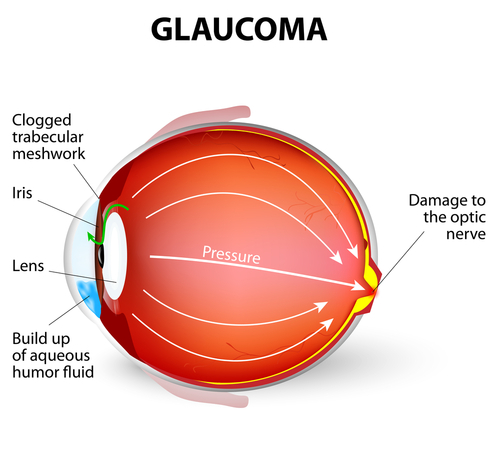
Glaucoma affects millions of people worldwide, yet many remain unaware they have this sight-threatening condition until significant vision loss has already occurred. Often called the “silent thief of sight,” glaucoma typically progresses without noticeable symptoms in its early stages, making awareness of potential warning signs crucial for preserving your vision.
Knowing the subtle signs that may indicate glaucoma can make the difference between maintaining healthy vision and facing irreversible vision loss.
What is Glaucoma?

Glaucoma is a group of eye conditions that damage the optic nerve, which serves as the primary communication link between the eye and the brain. This damage typically occurs when increased pressure builds within the eye due to problems with the eye’s natural drainage system.
Under normal circumstances, a clear fluid called aqueous humor flows into and exits the eye at a steady rate, maintaining healthy intraocular pressure. When blockages prevent this fluid from draining properly, pressure builds and begins to damage the delicate optic nerve fibers.
Without proper treatment, this damage progresses and can ultimately result in partial or complete vision loss. The challenging aspect of glaucoma is that most people experience no early symptoms or pain from this increased pressure.
Vision loss typically begins in the peripheral areas, which your brain often compensates for initially, making the condition difficult to detect without professional examination.
Open-Angle Glaucoma Warning Signs
Open-angle glaucoma accounts for the majority of glaucoma cases and presents the greatest diagnostic challenge due to its subtle progression. In this form, the drainage angle between the iris and cornea remains open, but the trabecular meshwork, which is the eye’s internal drainage system, becomes progressively clogged.
Peripheral vision changes are the earliest detectable sign, involving a gradual loss of side vision or peripheral sight. Many patients don’t notice this initially because their central vision remains sharp and clear.
You might find yourself missing objects or people approaching from the side, or having difficulty seeing while driving, particularly when changing lanes or navigating intersections. As the condition progresses, vision loss continues moving inward from the edges of your visual field.
This creates a tunnel-like effect where you maintain clear central vision but lose increasing amounts of your surrounding sight. Advanced stages may leave patients with only a small central area of remaining vision or complete visual impairment.
Angle-Closure Glaucoma Warning Signs

While less common than open-angle glaucoma, angle-closure glaucoma can present with dramatic symptoms that require immediate medical attention. In its chronic form, angle closure glaucoma occurs when the drainage angle of the eye is too narrow or partially blocked, leading to increased eye pressure.
An acute angle-closure attack occurs when the drainage angle becomes completely blocked, causing rapid pressure increases. Patients may see rainbow-colored halos around lights or experience unusual light sensitivity.
These symptoms result from corneal swelling caused by elevated eye pressure and should prompt immediate evaluation by an eye care professional. Severe eye and head pain often accompanies acute angle-closure attacks, as well as nausea, vomiting, and blurred or hazy vision.
Any sudden vision loss, particularly when accompanied by eye pain, indicates a medical emergency. Acute angle-closure glaucoma can cause rapid, permanent vision damage without prompt treatment, so it’s vital to seek immediate care.
The Importance of Regular Eye Examinations
Given that most glaucoma cases develop without early warning signs, regular comprehensive eye examinations are your best defense against vision loss. Dr. Hayden recommends annual eye exams for adults over 65, with more frequent monitoring for individuals at higher risk.
During your glaucoma evaluation, Dr. Hayden measures your intraocular pressure using advanced optical coherence tomography (OCT) technology. The examination also includes assessment of your optic nerve health, visual field testing to detect early peripheral vision changes, and evaluation of your eye’s drainage angle structure.
Certain factors increase your glaucoma risk and may warrant more frequent monitoring. These include having a family history of glaucoma, being older than 60, having African American, Asian, or Hispanic ancestry, having previous eye injuries, long-term steroid use, and having certain medical conditions like diabetes or high blood pressure.
Advanced Treatment Options at Hayden Vision

Early detection enables Dr. Hayden to implement treatment strategies that can effectively slow or halt glaucoma progression. Treatment typically begins with prescription eye drops designed to reduce intraocular pressure by either decreasing fluid production within the eye or improving drainage.
For patients requiring additional intervention, Hayden Vision offers advanced options including selective laser trabeculoplasty (SLT), which uses targeted laser energy to improve drainage through the eye’s natural channels. This minimally invasive procedure can reduce dependence on daily eye drops while effectively lowering eye pressure.
The innovative iStent technology offers another minimally invasive option for patients undergoing cataract surgery who also have mild to moderate glaucoma. This microscopic device, smaller than the period at the end of this sentence, creates a permanent bypass through the eye’s blocked drainage system.
Patients receiving iStent often reduce their need for glaucoma medications while maintaining healthy eye pressure. For severe cases, Dr. Hayden performs trabeculectomy procedures, creating new drainage pathways to manage intraocular pressure when other treatments prove insufficient.
Take Action to Protect Your Vision
The most effective approach to preventing glaucoma-related vision loss involves proactive monitoring rather than waiting for symptoms to appear. Since early-stage glaucoma rarely produces noticeable symptoms, many patients discover their condition only during routine eye examinations.
If you notice any changes in your peripheral vision, experience sudden eye pain or pressure, see halos around lights, or have risk factors for glaucoma, schedule an evaluation with Dr. Hayden promptly. Even subtle changes in your vision warrant professional assessment, as early intervention provides the best opportunity for preserving your sight.
Schedule your comprehensive eye examination at Hayden Vision in Evansville, IN, today to ensure your eyes receive the expert care they deserve.
